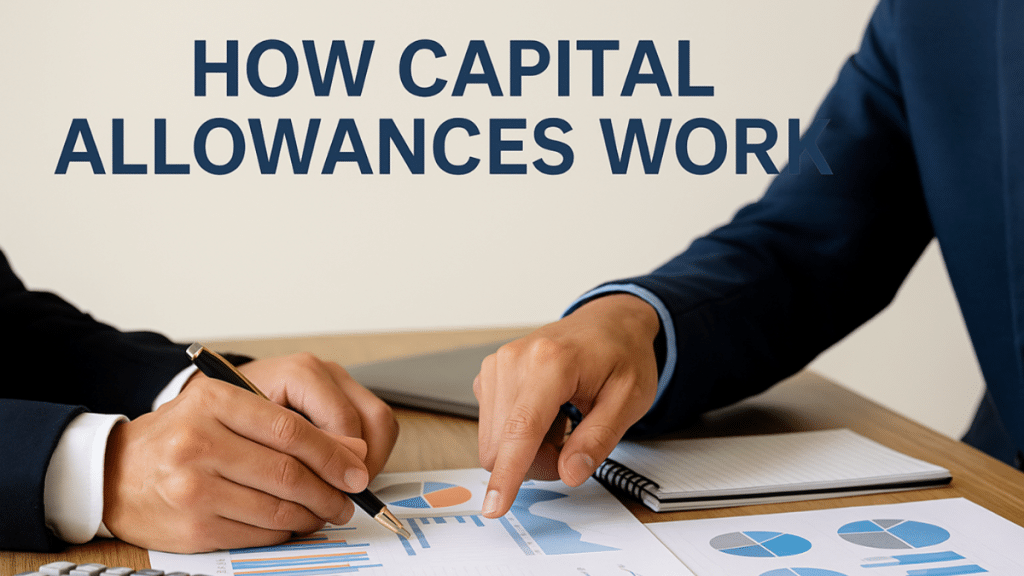Many business owners ask: How do capital allowances work? Can these allowances help reduce tax liabilities? What assets qualify? Understanding capital allowances is essential for businesses aiming to optimise their finances and improve cash flow. These tax reliefs allow companies to deduct the costs of qualifying capital expenditures from their taxable profits, effectively lowering tax bills. This article provides a comprehensive overview of how capital allowances work, highlighting key points that business owners should consider to maximise their benefits.
Capital Allowances
How do capital allowances work? Capital allowances are a form of tax relief provided to businesses that invest in qualifying assets. Instead of deducting the full cost of these assets as an expense in the year of purchase, companies can claim allowances over several years. These deductions reduce the taxable profit, leading to lower corporation tax payments.
Assets that qualify typically include equipment, machinery, integral building features (such as electrical systems and lifts), and certain vehicles. By claiming these allowances, businesses can recover part of their investment, supporting financial stability and reinvestment opportunities.
Why Are Capital Allowances Valuable for Businesses?
For businesses, capital allowances offer:
- Improved Cash Flow: Reducing taxable income frees up capital that can be reinvested or used for operational needs.
- Encouragement to Invest: The tax savings incentivise businesses to invest in essential equipment and infrastructure.
- Support for Sustainability: Certain allowances target energy-efficient or environmentally beneficial investments, aligning with corporate responsibility goals.
Understanding and utilising capital allowances effectively ensures businesses are not missing opportunities to reduce costs and improve financial efficiency.
Common FAQs About Capital Allowances
How do capital allowances differ from regular business expenses?
Regular expenses, such as salaries or rent, are deducted in full from the taxable income for the year. Capital allowances apply to long-term asset investments, with deductions spread over time.
What types of assets qualify?
Eligible assets include plant and machinery, integral building features, certain vehicles, and fixtures in commercial properties. Expenditures on land and buildings generally do not qualify, though integral features within buildings may.
Are capital allowances available to all businesses?
Yes, all businesses, regardless of size or sector, can claim capital allowances for qualifying expenditures. This includes sole traders, partnerships, and limited companies.
Can I claim retrospectively?
Yes. Businesses can amend previous tax returns to include capital allowance claims, subject to specific time limits.
Categories of Capital Allowances
- Annual Investment Allowance (AIA)
AIA provides 100% tax relief on qualifying expenditures up to a set limit (£1 million for most businesses). This applies to the purchase of equipment and machinery, allowing immediate deduction in the year of purchase. - First-Year Allowances (FYAs)
FYAs offer 100% relief for environmentally beneficial assets, such as energy-efficient equipment. This encourages businesses to make sustainable investments. - Writing Down Allowances (WDAs)
WDAS apply to expenditures exceeding the AIA limit or those not covered by FYAs. Over time, these allow deductions at set rates (e.g., 18% for main pool assets or 6% for special rate items).
Selecting the correct category ensures that businesses maximise their claim potential.
How Capital Allowances Support Business Strategy
Incorporating capital allowances into financial planning can support business growth by:
- Enabling quicker recovery of investment costs
- Freeing up resources for additional investment
- Encouraging the adoption of modern, efficient equipment
- Providing a structured approach to managing asset depreciation and tax planning
Strategic use of capital allowances can improve profitability and competitiveness, particularly in industries requiring ongoing capital investment.
Key Steps to Claim Capital Allowances
- Identify Qualifying Expenditures
Review recent capital investments to determine which assets are eligible. - Engage Professional Support
Specialists, such as surveyors or tax advisors, can ensure accurate valuations and compliance with regulations. - Gather Documentation
Collect purchase invoices, contracts, and evidence of asset use within the business. - Submit a Claim
Include the capital allowance claim in your corporation tax return, ensuring accuracy and adherence to HMRC guidelines.
Working with a trusted advisor can simplify the process and maximise claims.
Debunking Misconceptions About Capital Allowances
- “Only new assets qualify” Second-hand assets may also qualify if they meet the criteria.
- “Residential properties are excluded” While purely residential properties generally do not qualify, furnished holiday lets and communal areas in multi-unit buildings might.
- “It’s too complicated” Although the process can be complex, with the proper guidance, businesses can successfully navigate it and claim significant tax relief.
Clarifying these misconceptions empowers businesses to take full advantage of available allowances.
Recent Developments and Opportunities
The UK government has introduced incentives to encourage business investment. The Full Expensing initiative, for example, allows companies to deduct 100% of qualifying expenditures on plant and machinery incurred between April 2023 and March 2026. This policy supports faster capital recovery and stimulates investment.
HMRC said businesses claimed over £155 billion in capital allowances in the 2022/23 financial year, reflecting their essential role in business financial planning.
How to Integrate Capital Allowances Into Your Business Plan
- Assess Regularly: Review capital expenditure periodically to identify potential claims.
- Prioritise Sustainability: Consider investments that qualify for FYAs and align with environmental goals.
- Consult Experts: Engage with experienced professionals to ensure accurate and comprehensive claims.
- Monitor Deadlines: Ensure claims are made within allowable timeframes to avoid missing out on tax relief.
Effective planning integrates capital allowances into broader financial strategies, enhancing long-term success.
Conclusion
Understanding how capital allowances work is essential for businesses aiming to improve financial efficiency and reduce tax liabilities. Companies can unlock significant tax savings by identifying qualifying assets, selecting the correct allowance type, and ensuring accurate claims. Engaging with experts ensures businesses fully benefit from these opportunities.
Capital allowances are more than a tax benefit—they are a strategic tool that supports growth, sustainability, and competitiveness in an ever-evolving business landscape.
